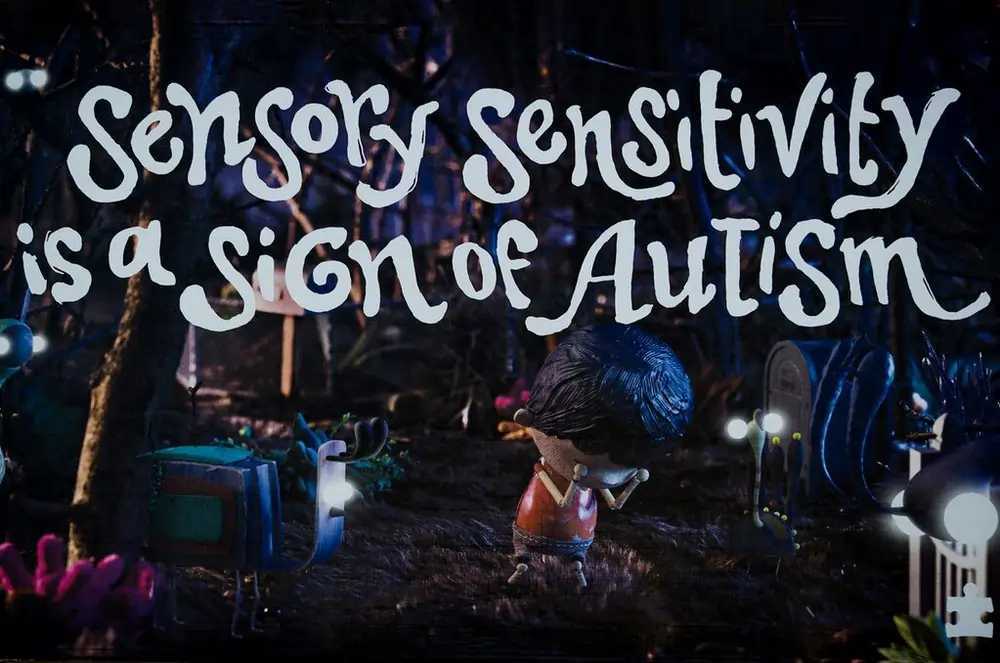Understanding Autism Symptoms Sensory Sensitivities : A Comprehensive Exploration

Sensory sensitivities are a prominent and often challenging aspect of Autism Spectrum Disorder (ASD). Individuals with autism may experience sensory stimuli—such as light, sound, touch, taste, and smell—differently from others. These sensory sensitivities can affect various aspects of daily life, including social interactions, academic performance, and overall well-being. This blog post delves deeply into sensory sensitivities, exploring their manifestations, impacts, and strategies for support and management.
What Are Autism Symptoms Sensory Sensitivities?
Sensory sensitivities in autism involve atypical responses to sensory inputs. These responses can be heightened (hyper-sensitivity) or diminished (hypo-sensitivity), influencing how individuals perceive and react to their environment. Understanding these sensitivities is crucial for creating supportive environments and effective strategies for managing them.
1. Hyper-Sensitivity

Hyper-sensitivity, or heightened sensitivity, means that an individual experiences sensory input more intensely than typically expected. This heightened perception can lead to discomfort, distress, or even pain. Key areas of hyper-sensitivity include:
- Auditory Sensitivity: Individuals may find everyday sounds overwhelming or unbearable. Common examples include the hum of fluorescent lights, the sound of a ticking clock, or the noise of a crowded room. These sounds can become sources of significant distress, leading to avoidance or shutdown behaviors.
- Visual Sensitivity: Bright lights, flashing images, or intricate patterns may cause visual overload. For some, fluorescent lighting in classrooms or workplaces can be particularly bothersome, leading to headaches or visual discomfort. Patterns or colors that others might find visually appealing can be distracting or unsettling.
- Tactile Sensitivity: Touch can be experienced more intensely. Textures of clothing, tags, or even the feel of certain fabrics might cause irritation or discomfort. Individuals might avoid certain textures or feel distressed when touched unexpectedly, even lightly.
- Olfactory Sensitivity: Scents that others find neutral or pleasant can be overwhelming. Strong perfumes, food smells, or cleaning agents may cause nausea or aversion. This sensitivity can impact dining experiences, public outings, and daily activities.
2. Hypo-Sensitivity

Hypo-sensitivity, or diminished sensitivity, occurs when an individual has a reduced response to sensory stimuli. This can lead to a need for more intense sensory experiences. Key areas of hypo-sensitivity include:
- Auditory Hypo-Sensitivity: Individuals may not notice or react to sounds that others typically hear. They might not be disturbed by loud noises or might seek out louder environments to achieve the desired level of auditory input.
- Visual Hypo-Sensitivity: A reduced sensitivity to visual stimuli might lead to seeking out bright lights or intense visual experiences. Dim or poorly lit environments may feel under-stimulating, prompting a need for more visual input.
- Tactile Hypo-Sensitivity: Individuals may not respond to gentle touches or minor injuries. They might seek out strong tactile sensations, such as rough textures or deep pressure, to achieve the sensory input they need.
- Olfactory Hypo-Sensitivity: Reduced sensitivity to smells may result in seeking out strong odors or not reacting to unpleasant smells that others find overpowering.
The Impact of Autism Symptoms Sensory Sensitivities
Autism Symptoms Sensory sensitivities can significantly impact various areas of an individual’s life, including social interactions, academic performance, daily activities, and emotional well-being.
1. Social Interactions
Autism Symptoms Sensory sensitivities can influence how individuals with autism engage in social settings. For instance:
- Social Settings: A person sensitive to loud noises might find social gatherings, parties, or crowded places overwhelming. This can lead to social withdrawal or avoidance of such environments. Conversely, someone with hypo-sensitivity might engage in louder or more stimulating environments to seek the sensory input they crave.
- Communication: Sensory overload can affect the ability to focus and process verbal communication. This can lead to difficulties in conversation or misunderstandings in social interactions.
2. Academic and Work Environments
In educational and professional settings, sensory sensitivities can pose challenges:
- Classroom Settings: A student with auditory sensitivity might struggle in a noisy classroom or find it difficult to concentrate due to background sounds. Visual sensitivities might make it challenging to work under fluorescent lighting or to engage with certain visual materials.
- Workplaces: In professional settings, sensory sensitivities can impact productivity and job performance. For example, a person sensitive to noise might find open-plan offices challenging or distracting, while someone with tactile sensitivities might struggle with uncomfortable uniforms or workspaces.
3. Daily Activities
Routine activities can also be affected by sensory sensitivities:
- Shopping and Dining: Environments like supermarkets or restaurants can be overwhelming due to bright lights, strong smells, and high noise levels. This can lead to avoidance of certain activities or places.
- Personal Care: Sensory sensitivities can impact personal care routines. For example, the feel of a toothbrush, the temperature of water, or the texture of toothpaste might cause discomfort or distress.
4. Emotional Well-Being
Autism Symptoms Sensory sensitivities can contribute to increased stress, anxiety, and frustration:
- Stress and Anxiety: Sensory overload can lead to heightened stress and anxiety, affecting emotional stability and overall well-being. Individuals might experience meltdowns or shutdowns as a response to overwhelming sensory input.
- Behavioral Challenges: Sensory sensitivities can contribute to challenging behaviors, such as aggressive outbursts or self-injurious actions, particularly when an individual is unable to escape or manage overwhelming stimuli.
Strategies for Managing Autism Symptoms Sensory Sensitivities
Addressing Autism Symptoms sensory sensitivities involves creating accommodating environments and developing personalized strategies to manage sensory experiences. Here are some effective approaches:
1. Environmental Modifications
- Lighting: Use natural light whenever possible and opt for softer, warmer lighting options. For those sensitive to bright lights, consider using dimmable lights or adding shades to windows. Tinted lenses or sunglasses can help reduce glare.
- Noise Control: Implement noise-canceling headphones or earplugs to manage auditory sensitivities. Creating a quiet space where individuals can retreat when overwhelmed can provide relief.
- Texture Management: Choose comfortable fabrics for clothing and bedding. Avoid tags and seams that may cause irritation. Providing sensory-friendly items, such as textured toys or sensory bins, can help individuals explore and manage tactile sensitivities.
- Smell Regulation: Use air purifiers or essential oil diffusers to control odors. Avoid strong-smelling products in shared spaces, and be mindful of scents in public places.
2. Sensory Diet
A sensory diet involves integrating sensory activities into daily routines to help regulate sensory needs:
- Sensory Breaks: Incorporate regular breaks throughout the day for sensory activities. These might include swinging, jumping on a trampoline, or using sensory toys like stress balls or fidget spinners.
- Deep Pressure Activities: Engage in activities that provide deep pressure input, such as using weighted blankets, receiving massages, or squeezing stress balls. These activities can be calming and provide a sense of security.
- Sensory Tools: Provide access to sensory tools and toys that cater to specific needs. For example, chewy necklaces can address oral sensory needs, while textured balls can provide tactile stimulation.
3. Personal Strategies
- Self-Awareness: Encourage individuals to recognize their sensory triggers and responses. Developing self-awareness can help in managing and communicating their sensory needs.
- Coping Techniques: Teach and practice coping techniques, such as deep breathing exercises, mindfulness, or calming routines. These techniques can help individuals handle sensory overload and reduce stress.
- Preparation and Planning: Prepare for potentially overwhelming situations by planning ahead. For example, visiting new places during quieter times or bringing comfort items can help manage sensory experiences.
Support for Families and Caregivers
Supporting individuals with sensory sensitivities involves understanding their unique needs and providing empathetic care:
1. Educate and Advocate
Educate yourself about sensory sensitivities and advocate for accommodations in various settings. Understanding sensory experiences and needs can lead to more effective support and inclusivity in schools, workplaces, and community spaces.
2. Create a Supportive Environment
Work with schools, employers, and community organizations to create supportive environments. This might involve implementing sensory-friendly practices, such as providing quiet areas or allowing flexible work arrangements.
3. Foster Open Communication
Encourage open communication about sensory experiences and needs. Creating a safe space for individuals to express their sensory preferences and challenges can help in finding effective solutions and reducing stress.
4. Seek Professional Support
Consult with occupational therapists or other professionals specializing in sensory integration. Professional guidance can provide valuable insights and support in developing personalized strategies and interventions.
Addressing Misconceptions
It is important to address and dispel common misconceptions about autism symptoms sensory sensitivities in autism:
1. Misconception: Autism Symptoms Sensory Sensitivities Are the Same for Everyone
Autism Symptoms Sensory sensitivities can vary widely among individuals with autism. Each person may experience different types and levels of sensitivity, making it essential to approach each case with an individualized perspective.
2. Misconception: Autism Symptoms Sensory Sensitivities Are Just Behavioral Issues
Autism Symptoms Sensory sensitivities are not merely behavioral issues but are rooted in how sensory information is processed in the brain. Understanding this can help in developing appropriate strategies and interventions.
3. Misconception: Autism Symptoms Sensory Sensitivities Will Improve on Their Own
While some individuals may develop coping strategies over time, autism symptoms sensory sensitivities often require ongoing support and accommodation. Addressing sensory needs proactively can improve quality of life and overall well-being.
Conclusion
Autism Symptoms Sensory sensitivities are a significant and complex aspect of Autism Spectrum Disorder. Understanding these sensitivities and their impact on daily life is crucial for providing effective support and creating inclusive environments. By implementing environmental modifications,
You may also like to read:



